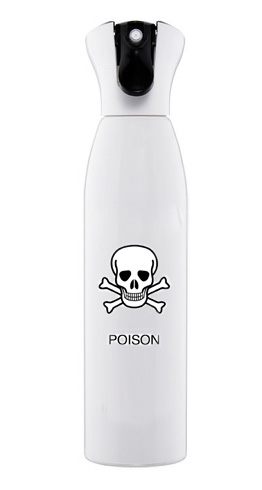Reusable Planet Blog: Which Air Freshener is Best?
Author: Rachel Date Posted:31 March 2023

DID YOU KNOW…?
Fewer than 10% of ingredients in air fresheners are typically disclosed by manufacturers to consumers? Even though they contain an average of 25 hazardous chemicals. And it’s completely legal under proprietary protection.
That’s corporate speak for secret recipe.
The global market for air fresheners was worth USD $12 Billion in 2021 and is predicted to rise to USD $22 Billion by 2027.
No wonder they don’t want their toxic secrets getting out.
CAN AIR FRESHENERS MAKE YOU SICK?
Generally used to ‘improve’ the quality of how our air smells indoors, it might surprise you to know the use of an air freshener can actually generate or further aggravate an air quality problem.
Your fresh-air-in-a-can emits over 100 different chemicals into the air. Approximately one quarter of them are classified as potentially hazardous pollutants, including formaldehyde (irritant), acetaldehyde (irritant and carcinogen), benzene (causes genetic damage), xylenes (irritant) and other reactive and evaporative compounds.
Constituents of air fresheners have been shown to trigger a myriad of health complaints, from minor irritations to asthma attacks and even leading to cancer and other diseases long-term.
These compounds can be adsorbed around your home on walls, fixings and furniture, and then be reemitted into the air.
Some of these toxic compounds can be relatively harmless in small doses. But many bioaccumulate in the body and the environment, making repeated exposure potentially more serious.
According to the US Environmental Protection Agency (EPA), air fresheners can irritate the eyes, nose and throat, as well as cause headaches and nausea and lead to damage to the liver, kidneys, central nervous system and cause cancer.
Some common complaints from air freshener exposure, even at low levels, include migraine headaches, asthma attacks, breathing and respiratory difficulties, dermatitis, earache and neurological problems.
For myself, I get an irritated nose and headaches when exposed to chemical scents like air fresheners. I can’t even wear perfume. I used diluted essential oils for fragrance, instead.
Specific air freshener chemicals such as acetaldehyde and synthetic phthalates have been associated with adverse respiratory, reproductive, immune, and endocrine system functions, and with cancer.
Acetaldehyde is a volatile organic compound (VOC) and is found occurring naturally in various plants. However, it’s classified as ‘hazardous with hazard category Carcinogenicity Category 2’ in Australia and is classified as a ‘carcinogenic hazardous air pollutant with no safe threshold of exposure’ by the EPA. It is the most abundant carcinogen in tobacco smoke.
As well as found (legally undeclared) in air fresheners, this friendly little cancer-causing chemical is also used in cosmetics, perfumes, toiletries, oral care products, household cleaning and washing agents such as disinfectants and detergents.
Read that again.
Not only do they emit toxic chemicals, air freshener components can react with molecules already in the air to create a secondary emission of new toxins.
Whether you use sprays, gels, solids, disks or oils, studies have shown they all emit chemicals classified as toxic or hazardous.
Because labelling of air fresheners is not regulated, even products labelled ‘green’, ‘natural’ or ‘organic’ have been shown to emit synthetic chemicals such as phthalates and other carcinogenic compounds.
These chemicals also affect the environment. In the United States, emissions of VOCs to the outdoors are regulated by the EPA mostly to prevent the formation of ozone, a constituent of photochemical smog.
HOW CAN THIS BE TRUE?
If you had no idea about all of this, you’re not alone. A survey of over a thousand Australians reported that 73.7% of Aussies were not aware that fragranced products can emit hazardous air pollutants.
The survey found 16.4% of respondents experience health problems when exposed to air fresheners, higher for asthmatics; 9.1% reported respiratory problems, 4.2% migraine headaches, 4.8% skin problems, and 4.5% asthma attacks, as well as skin problems, cognitive problems, gastrointestinal problems, cardiovascular and immune system problems.
The survey found 11.6% were unable or reluctant to use public toilets due to the presence of an air freshener or scented product.

WHAT ABOUT OUR FURRY FRIENDS?
And it’s not just humans. Pet MD recommends if you are using air fresheners, don’t use them around pets. It could cause your furry friends to cough, sneeze, irritate their eyes and nose, cause vomiting, diarrhea, lethargy, or even impact on appetite.
Long term effects are also possible, like feline asthma. Our feathered friends are even more sensitive to airborne toxins.
SO, WHAT CAN YOU DO ABOUT IT?
The issue of air fresheners, and many every day products containing synthetic chemicals and VOCs in general, raises health concerns similar to the debate previously had on second hand smoking.
You can’t smoke in public areas anymore, and now fragrance-free policies are beginning to be implemented in workplaces, schools, hospitals, and other indoor environments around the world.
In Australia, if you suffer from reactions to the chemicals emitted from synthetic fragrances, you might have a case under the Disability  Discrimination Act (DDA) to get a fragrance-free policy in your public space or workplace.
Discrimination Act (DDA) to get a fragrance-free policy in your public space or workplace.
And… you can stop buying chemical air fresheners and room deodorisers for your home! You’re far and away better off without them.
Honestly, I knew air fresheners were bad before I wrote this article, but after thoroughly researching for this, I am surprised that air fresheners are even legal, or at the least, regulated with transparency on the ingredients! We should all be outraged they permeate our supermarket shelves.
If you really feel the need to use an air freshener, burn a candle, try a diffuser or you can easily make your own! Here's my favourite super simple recipe.
Did you know about the dirty little secrets of air fresheners? We’d love to know in the comments. And make sure you share with a friend you think needs to be aware of this important issue.
Further Reading: Paper by Dr. Anne Steinemann, internationally recognised expert on pollutant exposures and associated health effects.
- - - - - - - - - - - - - - - - - - - - - - - - - - - -
All our blog articles written by Rachel or our Guest Bloggers are well researched by a real human person. We hope you have been informed, educated or entertained.
To read more eco living articles, head over to our main blog page.
If there is something you would like to see us write about, we’d love to hear from you! Send us an email or find us on our socials! We love spreading the message of reducing waste and the overuse of unnecessary plastic, so follow along and come be a change-maker with us!
Follow us on Instagram, Facebook or Twitter @ReusablePlanet or SUBSCRIBE and get weekly easy eco-living tips via email






